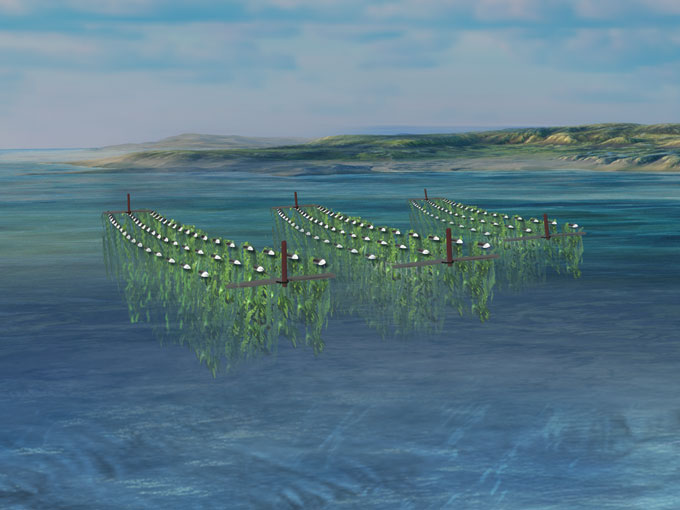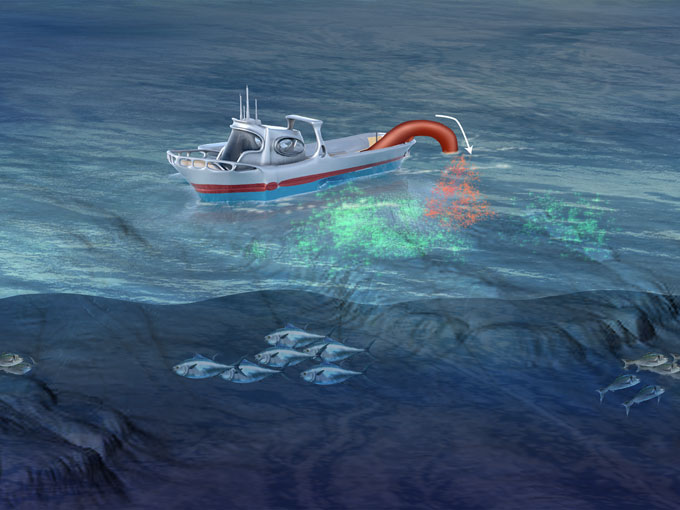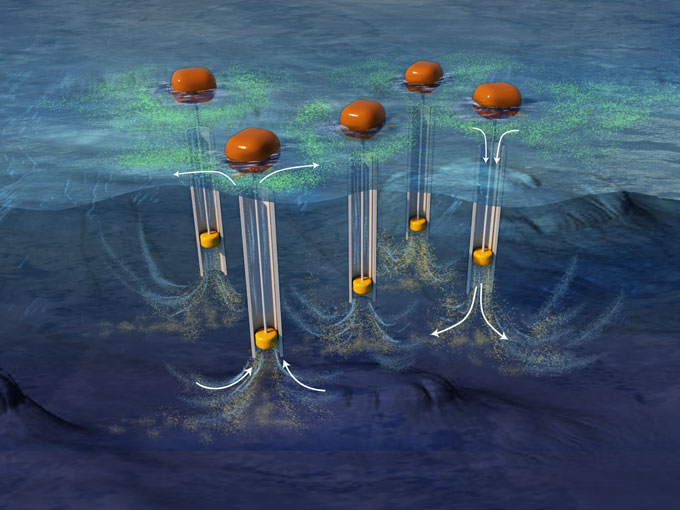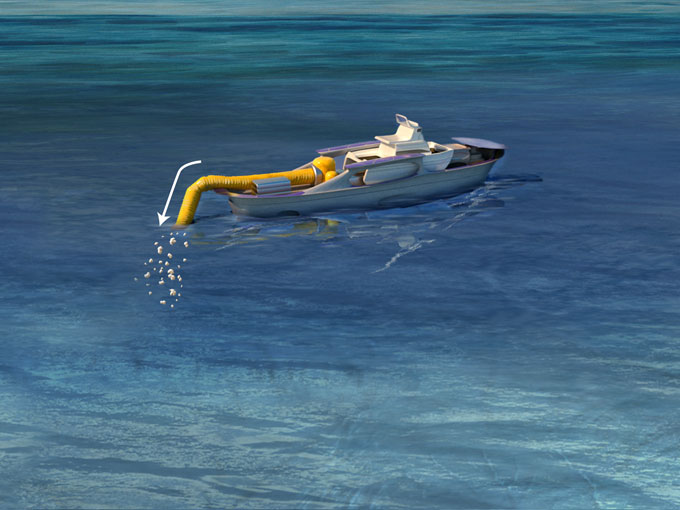The ocean is Earth’s climate hero.
For decades, ocean waters have helped hold back the juggernaut of global warming, absorbing at least a third of the carbon dioxide emitted by human activities since the Industrial Revolution began.
Now, the world may ask the ocean to do even more. That would require tinkering with the chemistry and biology of the ocean to increase how much carbon it takes up.
Such an approach is worth considering because the window for limiting warming by reducing carbon emissions alone is closing fast, climate simulations suggest. Forestalling the worst impacts of climate change by 2100 will require actively pulling carbon back out of the atmosphere — at a scale possible only with the ocean’s help, some scientists say.
Earth is on track to warm by about 3.2 degrees Celsius by the end of the century, relative to preindustrial times, according to the Intergovernmental Panel on Climate Change. Even if all nations meet their current emission-reduction pledges, the world would still warm by about 2.7 degrees (SN: 10/26/21).
That’s higher than the target of 1.5 to 2 degrees set by the 2015 Paris Agreement, an international climate treaty signed by 195 parties. In fact, Earth’s average temperature is likely to surpass the 1.5-degree benchmark as soon as the mid-2030s (SN: 12/15/23). Each uptick in the thermostat increases the risk of devastating consequences, including deadly heat waves, more intense storms and inundations of coastal cities due to melting ice and rising seas.
Technologies that remove carbon from the atmosphere could help turn the thermostat back down by the end of the century. “The latest IPCC report notes that to meet the [Paris Agreement] climate goals, we have to employ carbon dioxide removal technologies,” says geochemist Gabriella Kitch of the U.S. National Oceanic and Atmospheric Administration in Silver Spring, Md.
Carbon dioxide removal, or CDR, is in its infancy, currently drawing only about 2 billion metric tons of CO2 per year out of the atmosphere. That’s a small fraction of the 37 billion tons of CO2 emitted each year by humans’ energy consumption. Most of that CDR comes from forests, whether via planting new trees, regrowing old forests or better managing existing growth (SN: 7/9/21).
To stay on track with Paris Agreement goals, the world needs to ramp it up, removing 10 billion to 15 billion tons of CO2 annually by 2050, Kitch says. By the end of the century, that would need to add up to a grand total of 400 billion to 1,000 billion tons of atmospheric CO2, a range that depends on how quickly we also reduce carbon emissions.
Land-based CDR, including planting trees, restoring coastal ecosystems and building facilities that directly capture CO2 from the air, can get us part of the way there, Kitch says. But all of the carbon uptake from land-based approaches would add up to only about 10 billion tons annually, Kitch says. Such calculations need to ensure sufficient land area for food, water and biodiversity preservation, she adds. “That gets us to 2050, but what about beyond that?”
That’s where the ocean comes in. “The big advantage of the ocean is its capacity,” Kitch says. “The ocean can store about 19 times the amount of carbon that can be stored on land.”
There are a few basic ways to enhance the ocean’s current carbon uptake: Increase the ocean’s abundance of photosynthesizing organisms, increase the water’s alkalinity so it can absorb more acidic CO2 and build huge facilities at sea that suck carbon directly out of the water.
But CDR in the big blue is largely untested — and in that sense, the ocean’s vastness is both a feature and a bug. Ocean waters are complex and always in motion, making shifts in chemistry fiendishly difficult to monitor. And there’s little baseline data on large swaths of the ocean, which will make it hard to evaluate how well CDR is working. And current observational technologies, such as sensors, may not be up to the challenge.
On top of that, there are also long-standing concerns about environmental impacts, of which there’s very little data. Changes to regional water properties might create ripple effects through ecosystems, critics note. Fostering phytoplankton blooms, for instance, could shift local food webs or even produce greenhouse gases. Treating large parcels of seawater to remove carbon could pose risks to local wildlife.
But the biggest challenge of all is time. Researchers are racing to explore these uncharted waters before the climate crisis worsens.
How carbon dioxide removal could slow climate change
Carbon dioxide can linger in the atmosphere for centuries before it’s taken up by plants or incorporated into the molecular structure of rocks. Those natural carbon “sinks” are too slow to match the pace of emissions from fossil fuel burning and other human activities, however.
CDR can be thought of like “a time machine,” David Ho, an oceanographer at the University of Hawaii at Manoa, wrote last year in Nature. Stripping some of the CO2 out of the atmosphere would be like returning to an earlier time with lower concentrations.
For example, the world’s largest direct air capture plant, Climeworks’ Iceland-based Orca plant, can remove up to 4,000 tons of CO2 each year. That might set the clock back by perhaps three seconds annually, Ho estimated.
Planting 100 million trees around the globe buys back about 33 minutes annually, says paleoclimatologist Peter de Menocal, president and director of the Woods Hole Oceanographic Institution in Massachusetts.
Today, the ocean naturally absorbs about a quarter of the world’s carbon emissions annually. That’s equivalent to setting the clock back by about three months each year.
The ocean’s carbon storage capacity is vast. For example, from 10,000 years ago until the dawn of the Industrial Revolution, the atmospheric CO2 concentration was about 280 parts per million. But at the height of the last ice age, about 20,000 years ago, that concentration was just 180 ppm. The “missing” 100 ppm of CO2 during the ice age was all stored in the ocean, in part due to decreased ocean circulation at this time.
“Sixty years ago, atmospheric carbon dioxide levels were [also] 100 parts per million lower than they are today,” de Menocal says. In other words, natural ocean uptake has the ability to set the clock back by as much as 60 years. With ocean-based CDR, the clock could be pushed back even further.
But potential is not proof. “Almost all [CDR strategies] are in the early days,” says Jessica Cross, a carbon biogeochemist at the Pacific Northwest National Laboratory in Seattle.
Highlighting the urgent need for more research, the U.S. National Academies of Sciences, Engineering and Medicine suggested in 2021 that nearly $2.5 billion in research funding over the next decade is needed to really drive the field forward.
An influx of funds arrived last September, when the U.S. National Oceanographic Partnership Program, a funding alliance that bridges federal agencies, academia and industry, awarded over $24 million to fund 17 ocean CDR research projects. In October, the Department of Energy announced $36 million in funding for 11 other projects.
The snapshots below feature the most-discussed types of ocean CDR, revealing the pros and cons of each strategy, plus the key questions that researchers must answer before society moves forward.
Seaweed farming
Red, green and brown seaweed — or in scientific circles, macroalgae — are speedy growers, with some species shooting up by tens of centimeters per day. To fuel that growth, these photosynthesizers rapidly absorb CO2 from the ocean. When the algae die, they sink down to the depths, where the carbon may cycle through deep-sea food webs or be buried in sediments, lingering for decades to centuries.

Seaweed farming speeds up this natural biological pump by growing algae on offshore floating platforms and then sinking the platforms to deep water once the algae are fully grown. Natural macroalgae populations in coastal waters around the world sequester somewhere around 0.17 billion tons of carbon each year, researchers reported in 2016 in Nature Geoscience. Cultivating seaweed could increase that to about 1 billion tons annually, according to a 2022 report by the National Academies of Sciences, Engineering and Medicine.
That’s if the seaweed is allowed to sink rather than be consumed. Although seaweed has been suggested as a climate-friendly food, feedstock or biofuel, consuming it would return the carbon to the atmosphere (SN: 5/9/22).
Macroalgae alone probably wouldn’t make a huge dent in the amount of carbon the world needs to sequester and wouldn’t store it for very long. Climate simulations of the impact of seaweed farming also suggest that the algae might end up competing for nutrients with phytoplankton — floating microscopic “plants” also being looked to for climate assistance.
Ocean iron fertilization
Although the Amazon rainforest is often called the lungs of the world, ocean phytoplankton also deserve the moniker. These photosynthesizing organisms produce at least half of the oxygen in the atmosphere, while pulling out carbon dioxide.
Like land plants, phytoplankton need sunlight, CO2 and nutrients such as nitrate and phosphate to live. And to really thrive, they also need smaller infusions of certain micronutrients, particularly iron, which can be in short supply in many parts of the ocean.

Observing how iron-laden dust blowing from continents to the ocean leads to large blooms of phytoplankton, American oceanographer John Martin proposed in the 1980s artificially adding the nutrient. The iron could kick-start additional blooms that would soak up more carbon — thereby lowering global temperatures. “Give me a half tanker of iron, and I will give you an ice age,” he famously once said.
Scientists tested the concept of ocean iron fertilization 13 times from 1993 to 2009, dumping iron sulfate into patches of the eastern equatorial Pacific, northern Pacific and Southern oceans (SN: 12/2/21). These experiments confirmed that adding iron makes the ocean bloom. But they were too small and too brief to address how much CO2 was removed from the atmosphere and how long it was sequestered in the deep ocean, says Ken Buesseler, a marine chemist at Woods Hole.
The experiments also produced a bloom of environmental backlash. Critics worried that seeding the ocean might lead to toxic algal blooms or even ocean dead zones, as the eventual decomposition of dead phytoplankton might remove too much oxygen from the water and release methane, itself a greenhouse gas. In 2008, the United Nations Convention on Biological Diversity stepped in, calling for a moratorium on these experiments “until there is an adequate scientific basis on which to justify such activities” and there are regulatory mechanisms in place. After that, ocean iron fertilization experiments were dead in the water. “The pushback was so strong,” Buesseler says, “we just couldn’t find any funding.”
But things are very different now as a result of the climate crisis, he says. “There’s absolutely a big change, working in this area, from 15 to 20 years ago.” In 2022, he and colleagues formed the Exploring Ocean Iron Solutions consortium, identifying key research questions for the field and proposing best practices for studying them. This time, societal acceptance and citizen participation are highlighted as core features of any ocean fertilization project.
In September, Buesseler and colleagues were among the National Oceanographic Partnership Program’s awardees, receiving almost $2 million to fund a three-year research project to investigate the long-term effects of using iron fertilization in different regions of the ocean.
In some ways, ocean iron fertilization is among the further-along CDR technologies — but it’s far from ready for prime time. “We have to come up with a way to scale this up that would be acceptable and reproducible,” and address the long-standing environmental concerns, Buesseler says.
One challenge is developing a way to assess the amount of carbon captured from the blooms and the duration of storage as phytoplankton sink toward the ocean bottom. Other outstanding questions include what form of iron offers the most bang for the buck. It could be a liquid solution of iron sulfate, dry dust, iron nanoparticles or even floating, iron-coated rice husks.
Artificial upwelling and downwelling
Some of the best fishing grounds in the world are off the western coast of Peru, the result of a complicated dance between Earth’s rotation and prevailing winds blowing along the shore. Redirected by the Coriolis effect, the winds push nutrient-depleted surface waters away from the shoreline, and then cooler, deep, nutrient-rich water surges up to replace the surface waters, juicing the regional food web.

Artificially re-creating this upwelling effect by pumping nutrient-rich waters from the deep ocean toward the surface could be another way, theoretically, to give phytoplankton a boost. Similarly, carbon-laden surface waters might be sent downward to be sequestered. That could be achieved through pumping or by altering the density of the water, either by increasing the water’s salinity or decreasing its temperature.
That artificial upwelling could also increase the effectiveness of seaweed farming or ocean iron fertilization, computer modeling studies suggest. But there are a lot of caveats: Deep water can contain a lot of carbon that, if pumped toward the surface, might escape to the atmosphere. And the long-term impacts of artificial upwelling and downwelling, both on carbon sequestration and on the denizens of the deep, are unknown. Pumping would also require a lot of energy, which could lead to a release of carbon into the atmosphere if the energy source is based on fossil fuels.
Enhanced rock weathering
It takes thousands to millions of years for wind and rain to erode rocks on land, for those rocky grains to then disintegrate and drift into rivers, lakes and groundwater, and ultimately find their way into the sea. The dissolved remnants of those rocks give the ocean its acid-buffering ability, known as alkalinity. Thanks to that alkalinity, as carbon dioxide enters the ocean from the atmosphere, the gas reacts and transforms into dissolved carbonate molecules, particularly bicarbonate. Ultimately, the carbon ends up in carbonate sediments on the seafloor, where it can stay sequestered for as long as 100,000 years.
Enhancing the ocean’s alkalinity could allow the ocean to take in even more carbon. Boosting the alkalinity would also counter ocean acidification, which threatens to erode the carbonate shells of many sea creatures (SN: 4/28/17).

One way to enhance alkalinity is to simulate rock weathering by dumping large amounts of finely ground alkaline minerals, such as sodium hydroxide, magnesium hydroxide or calcium hydroxide, into the water. Researchers have done just that in a few pilot projects, including in Florida’s Apalachicola Bay in 2022 and in Canada’s Halifax Harbor in 2023. These tests demonstrated the ability to neutralize acid and draw some CO2 out of the atmosphere. But there’s not much real-world data yet on how by-products of the minerals, such as trace metals, or changing the ocean’s pH might impact sea life.
Planetary Technologies, a Canadian company that won a $1 million XPRIZE for climate change solutions in 2022, faced local protests to its plan to deploy magnesium hydroxide through a waste pipe into St. Ives Bay, England, in September 2023. Protestors called for much more scientific study of how the test might impact the bay’s wildlife, including the region’s prized gray seals.
“We’re here today for our children’s futures. We want them to be able to enjoy the bay for years to come,” a protestor told the Guardian last year. “We don’t know what the outcome will be if they dump these chemicals into the sea.”
Some critics also cite other environmental costs, such as the mining and transporting of the minerals.
Electrochemical alkalinity enhancement
Electrochemically removing acid from ocean water is another way to increase alkalinity. This method proposes to pump seawater through an ocean-based electrochemical system. The electricity would rearrange the molecules of water and salt, splitting them into two solutions, one acidic and one alkaline.
The alkaline solution would be mixed with seawater and returned to the surface ocean, increasing the water’s alkalinity so the water can pull more carbon dioxide out of the atmosphere. The acidic portion, meanwhile, might be neutralized, diverted to industrial markets or perhaps stored in deep ocean waters or the seabed.
Numerous unknowns surround the environmental impacts of this approach, including how pumping large volumes of seawater and changing water chemistry might impact marine life and local ecosystems.
Existing electrochemical systems are expensive. Pumping the seawater and splitting the molecules requires a lot of electricity, which could result in a large carbon footprint if not from renewable sources. Building the infrastructure for such a system could also be costly, though repurposing the acidic solution might help recoup the costs. Combining the technique with offshore energy generation, such as wind turbines, could help offset both the carbon footprint and costs.
The concept has remained largely lab-based, but in August, the American start-up Ebb Carbon unveiled a prototype electrochemical CDR facility at Sequim Bay in Washington. The pilot project, a partnership with the Pacific Northwest National Laboratory, aims to demonstrate that it can capture 100 tons of CO2 per year.
Direct ocean capture
Another option is to directly strip carbon dioxide out of large parcels of water and then bury it in the deep ocean. Ocean-based direct capture is also an electrochemical method that shunts seawater through a large membrane. The membrane then mediates a reaction between the seawater and another solution, such as a sodium hydroxide solution, that strips out dissolved carbon dioxide. This process ultimately increases the surface water’s pH, allowing it to absorb more atmospheric carbon dioxide. It’s a technology that can be fully offshore, so it doesn’t require valuable land area. And, theoretically, it could be powered by renewable energy.

One big disadvantage is the cost due to the massive amounts of water that have to be circulated through the facility, as well as the expense of the large membranes needed to treat the seawater. Drawing in large amounts of seawater to the facility could also pose risks to marine organisms. And little is known about how changing the properties of the seawater could affect nearby marine life.
Direct ocean capture technology has only recently moved out of the laboratory. In 2022 and 2023, the start-up company Captura, founded by Caltech researchers, conducted ocean field trials of the technology at Newport Beach and the Port of Los Angeles. The group is planning two pilot projects this year in Canada and Norway.
The future of ocean carbon dioxide removal
If CDR becomes a success, it will likely require several approaches working in tandem. Cross, the biogeochemist at the Pacific Northwest National Laboratory, points to one study, published in Nature Climate Change last year, that “lives rent-free in my brain.” The paper suggests that “the more different methods of CDR that you have, the fewer challenges from each different method you may be incurring all at once,” she says, such as competition for land and water, or the massive energy costs associated with crushing rock for enhanced weathering or pumping large volumes of seawater. “That way you avoid the cascading problems,” she says.
The ocean research community is now awash in discussions of how best to create a responsible research agenda.
The intense societal pushback to some early field tests of ocean CDR highlights “how challenging it’s going to be to do this kind of work,” and how crucial it will be to have communities on board every step of the way, Cross says.
“Emotions tend to run high when we’re talking about our coasts,” she adds. “The ocean is a cultural asset, an economic asset, a real estate asset, a sport asset. These concerns are there for all forms of ocean CDR. Is this going to change the look and feel of my ocean in my backyard?”
source site

